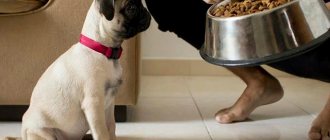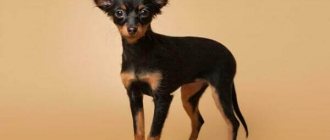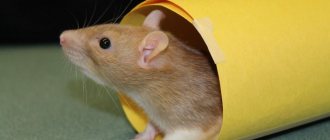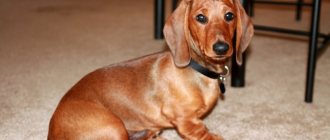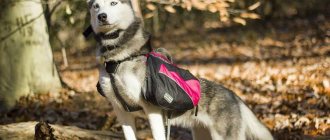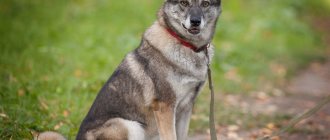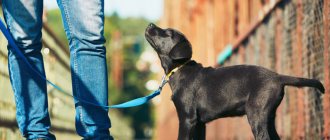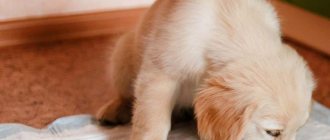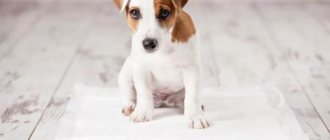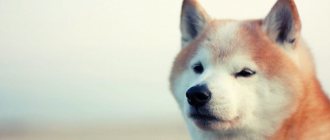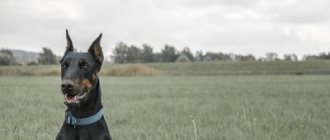Huskies have a rather willful and independent disposition and, if not raised properly, can be prone to disobedience, which sometimes makes even caring for them quite difficult.
For many Husky owners, especially inexperienced ones, training their pets at home seems to be a very difficult task.
In fact, it is not so difficult to train a husky well, if you take into account the breed and individual characteristics of the dog.
After all, it is in the process of learning and communicating with a pet that the foundations of its relationship with the owner are built and their roles are distributed in the family-pack.
Do you need to train a Husky?
Like any other dog, a husky needs timely socialization, as well as proper education and training from childhood.
If you neglect the education of such a pet and do not train it, this can lead to very unpleasant consequences, to the point that an ill-mannered husky will completely stop obeying its owners and begin to do only what it pleases.
NOTE!
It happens that, not finding authority in the person of its owner, a husky that has not been properly trained may even run away from home and go in search of a new owner, who will become a real “leader of the pack” for him.
Huskies are naturally intelligent and quick-witted, but at the same time they are also quite headstrong, stubborn and very cunning. They pick up new commands on the fly and, if not for the reluctance to do what the dog itself considers pointless, training a husky would not present any difficulties.
The main task of the owner is to make the pet do what is required of it.
An inquisitive mind and high intelligence often push huskies to play pranks, and therefore, when raising them, it is not enough to simply instill good manners in the dog and teach it basic commands. It will also be necessary to try to anticipate the pet’s intentions and, if he is preparing some kind of prank, stop him in time.
Why train an animal?
Socialization and training are important for every dog, but especially for wayward huskies. Neglecting training leads to very undesirable consequences, since an untrained pet can eventually get completely out of hand and do whatever it wants.
Representative of the breed
Huskies are very smart, prone to pranks and games, and are able to think through and carry out an adventurous venture in advance. That is why it is important not only to accustom your pet to good behavior by teaching commands, but also to try to predict unwanted behavior and stop it in a timely manner.
Note! Representatives of the breed, in the absence of training, do not consider the owner to be an authority and are prone to escape.
At what age should you start?
A husky puppy is taught the simplest commands from scratch from the very first days of his arrival at his new home. It is recommended to move on to more serious teams later - from 3-4 months.
However, it is recommended to focus more not on average indicators, but on the individual characteristics of the pet.
Some puppies are already ready to accept relatively complex commands at 2-2.5 months and willingly learn them, while others are ready for serious training much later, by 4.5-5 months.
Where to start education?
You need to start raising a puppy by teaching him a nickname, a place to sleep, keeping the house clean, as well as commands such as “Come”, “No”, “Ugh”.
The main thing at the initial stage of raising a husky should not be the number of commands the baby has learned, but the formation of his relationship with members of his owner’s family. Also at this age, manners in the house are taught - the puppy is taught to eat, sleep and use the toilet in a certain place.
The main thing that a puppy must learn at the initial stage of training is that the owner and his family members occupy a higher social status in the family, and that the dog must fulfill all their requirements.
At the age of 1.5-3 months, classes should not be too long, since the puppy is still too small, he gets tired quickly and is often distracted by extraneous stimuli. Therefore, the most optimal time for training will initially be 10-15 minutes, and later the training can be increased to 1 hour.
Expert opinion
Kozhevin Semyon Kirillovich
Expert dog handler.
“The sooner you start raising a pet, the better. After all, improperly trained huskies, due to their willful nature and stubbornness, can cause a lot of problems for their owners, for example, by simply ceasing to obey and doing whatever they want. When choosing a training method, it is best to give preference to activities conducted in the form of a game. Huskies are not too willing to obey commands in order to serve their owner, and they simply do not accept forceful methods of influence. If the training takes place in a playful way, then it will be much easier for the owner to interest the pet and force it to do what is required.”
Bad habits
Bad habits of huskies include:
- They do not like to be separated from people, as they are very friendly dogs.
- Chasing cats and cats.
- They chew everything they come across (most often happens to puppies when they are teething).
- It's a mess all around. This happens because they need to throw out energy somewhere.
- Jumping on owners and other people - this happens due to its friendly nature.
Why does he run away from his owners?
The reason for this phenomenon lies in the very origin and homeland of these dogs. Huskies are northern sled dogs. That's why they are constantly running somewhere. In addition, they may simply be afraid of their owner if he treats them too harshly. There is a third explanation for such actions - disobedience. Therefore, the owner needs to work with his pet.
The dogs destroyed the apartment
This happens due to insufficient physical activity. For a husky, you need to spend two hours walking every day. You should play active games with your dog outside so that the animal can splash out all its energy, while at home it can rest.
Growls at the owner
A dog, as a rule, is a pack animal, and therefore is very hierarchical. If a dog growls at its owner, then this is a fairly big problem, and the whole issue lies in the dog’s upbringing itself. This means that the dog considers himself to be in charge, and this should not be allowed. To prevent him from growling, you should take a noose and a muzzle: as soon as he growls at the owner, he needs to be lifted and shaken - this way several times.
What can be taught?
In addition to working as a sled dog, Huskies can also be trained in many other sports, such as agility or freestyle, and these dogs can also learn many circus tricks. But only under one condition - if the owner manages to interest his pet in one or another type of activity.
In addition, with the right approach to training, huskies are good at learning basic commands from OKD or UGS courses.
IMPORTANT!
When choosing a training course for huskies, it is necessary to take into account that representatives of this breed are completely unsuitable for the role of guard and hunting dogs, and therefore, training them in protective guard service or trying to train them in any game may be not only pointless, but also harmful.
Husky character and temperament
The Husky breed belongs to the primitive type, which means that it appeared as a result of the process of natural selection. The first owners of Siberian huskies were the aboriginal inhabitants of the North of Siberia, who made them suitable for riding. Under these conditions, the character traits of these dogs were formed. For example, Siberians are not suitable as guards and watchmen: thousands of years next to peaceful cattle breeders have made them completely devoid of aggression.
Huskies have characteristics that distinguish them from “cultured” breeds. Firstly, sociality. A sled dog is constantly surrounded by “colleagues”; an aggressive and unfriendly dog threatens survival in an icy desert, so the most sociable dogs were selected. Secondly, independence and intelligence. A striking example is the story of the huskies, who, by delivering medicine, saved the Alaskan city of Nome from a diphtheria epidemic in 1925. In conditions of an Arctic storm, at a temperature of -30, the leader unmistakably determined the direction, independently choosing a road, overcoming ice holes. In total, I covered 125 kilometers in two days. At the end of the journey, his legs gave out, but he brought the team.
The next trait is a heightened hunting instinct. Nomadic peoples fed dogs only in winter, but in the warm season they fed on their own. Inexperienced breeders often have many problems with neighbors who lose cats, chickens, rabbits, and sometimes small livestock.
So, the main character traits of this breed:
- intelligence;
- independence;
- lack of aggression towards humans;
- increased hunting instinct;
- sociality;
- endurance.
All these traits indicate the need for strict training.
Types of dog reflexes
There are two types of reflexes - unconditioned and conditioned.
Unconditioned reflexes are innate. They ensure the animal's adaptability to constant environmental conditions. These include protective, food, orientation and sexual reflexes.
Unconditioned reflexes are very difficult to correct, since they are fixed at the genetic level.
Conditional ones are developed in the process of everyday communication with a pet, as well as during its education and training.
As for conditioned reflexes, the main goal of raising and training a pet is precisely their development and consolidation, due to which the dog’s behavior is adjusted and models of its behavior are formed in certain situations.
Video
Raising an animal should be based on once-established rules. You cannot change the commands to which the dog is taught; you need to achieve their precise implementation in any conditions. Husky training will be more successful if it is accompanied by a walk and active games.
Raising an animal should be based on once-established rules. You cannot change the commands to which the dog is taught; you need to achieve their precise implementation in any conditions. Husky training will be more successful if it is accompanied by a walk and active games.
Methods of reward and punishment
When raising and training huskies, it is recommended to alternate methods of reward and punishment. It should be taken into account that any action of a pet must be reinforced in one way or another.
For example, if a husky has correctly completed a required command, it should be rewarded. If the pet has committed some kind of offense, then, of course, it must be punished. How to do this correctly?
It is believed that the best method of reward is to give your pet a treat. However, it must also be taken into account that not all dogs have predominant food reflexes. It is possible that for a certain dog, the best method would be verbal praise or play, when, for good work, the pet is allowed to play a little during a break between classes.
The reward treat should be small in size, no more than 1.5-2 cm on the longest side. In addition, it should not stain the handler’s hands or clothes.
It is most convenient to use some kind of dry food that your pet especially likes or, for example, drops for dogs as a treat for training. Hard low-fat cheese, cut into small cubes, is also well suited for these purposes.
NOTE!
The treat should not be one of those foods that the pet receives every time during feeding.
As for punishments, as mentioned above, methods of force are not very suitable for huskies. Under no circumstances should you hit your pet or yell at it too much.
It is considered acceptable to slightly raise your voice at a naughty husky or lightly spank him with a newspaper in case of disobedience, but hitting the dog too hard is unacceptable, since this will lead to nothing but anger and a final loss of trust in the owner.
How to punish and reward
As mentioned above, the characteristics of the breed dictate gentle training methods. Huskies are raised by often using praise in advance, seeing that the animal is trying to follow the command, but is not yet very successful. Physical punishment is used in exceptional cases. It involves shaking the dog by the scruff of the neck or pressing it to the floor. You cannot hit an animal.
Punishment should follow immediately after the offense. After just 5 minutes the dog will not understand why he was punished.
The reward method is chosen depending on the character of the pet. The vast majority of huskies are food eaters; they will happily fulfill their owner’s requests for a tasty bite. There are also dogs with play motivation. The owner's attention is important to them. After a successfully completed lesson with such a dog, they take a short break with a game of ball or fun fuss.
Even the most difficult dog to train can open up and show its best qualities with a patient and consistent approach.
How to teach behavior on the street?
Huskies begin to be taught proper behavior on the street even at a time when the puppy is quarantined at home and does not yet go out for walks. At this time, he is accustomed to a leash, collar , approach on the command “Come to me”, as well as prohibiting commands “No” and “Fu”.
It is useful to carry the puppy outside in your arms for a few minutes, without putting him down on the ground. This way, the little husky will quickly get used to the noise of the street, as well as to the sight of passers-by rushing about their business and moving traffic.
In this case, it is necessary to put a collar or harness with a leash on your pet as a safety net - even if the baby, scared of something, breaks out of your hands, it will not be difficult to keep him in place.
It is advisable that by the time the puppy starts walking, he has already been socialized and is calm about other people’s dogs and other animals.
After the quarantine is over, you can start real walks with your husky. Of course, in the city, a puppy, and even an adult dog, must always be on a leash, from which they can only be let off in a fenced area.
At first, you need to walk your husky on quiet, calm streets, where there is no busy traffic.
During walks, you need to make sure that the puppy does not grab pieces of food or other objects from the ground. Noticing that he is about to grab something, you need to give a prohibiting command, and, if this does not help, sharply, but not too hard, pull the leash.
Usually, after several repetitions of the command and subsequent jerks of the leash, the dog completely loses the desire to drag any nasty thing into its mouth.
Where to start training a husky
Husky training is special: these dogs themselves are fundamentally different from all breeds common in European countries.
People tried to instill in the local animals qualities that would help in solving the problems of owning property: its protection, protection from attacking enemies.
Trainers could also pursue opposite goals - the dog was taught to be an offensive weapon.
The Siberian Husky is not designed for any of these activities: it has lived for hundreds of years in a world where property is everything around it.
According to the dog, it cannot be mastered alone: one can conquer the vast expanse in a pack, completely subordinate to a powerful creature who knows what, why and when to do in order to achieve the goal.
Huskies have little interest in security; the dog has difficulty understanding who to bark at and why.
A sled dog, the leader is accustomed to commanding his own kind and obeying a person.
Knowing the characteristics of the breed makes it possible to answer questions about why and how to train a husky before purchasing a dog.
How to train a puppy to use the toilet in the house?
At home, it is most convenient to use a diaper as a dog toilet in an apartment. In the first days after the puppy arrives at home, you need to put him there after each feeding and when the baby wakes up. And in order for the little husky to try to use the diaper himself, it is recommended to place it close to the bed.
When the puppy begins to go there independently every time, the diaper can be gradually moved to the place where it is planned to arrange a permanent home toilet for the pet.
If the husky continues to confidently use the diaper even after it has been moved a little from its usual place, then everything is in order. If the baby cannot find the diaper, then you need to return it back and wait a few days, and then try to move it away again, but to a smaller distance than the previous time.
Services of our dog handlers:
Content:
- Puppy course
- Everything a Husky Puppy Owner Needs to Know
- Correcting unwanted behavior
- Training in necessary commands
- Obedience command training
- Aggressive behavior
- Preparation for the exhibition
- Where, when and how often do classes take place?
- Conditions of detention
How to toilet train outdoors?
You should accustom your husky puppy to the outdoor toilet only after the end of quarantine. To do this, you need to take him out or take him outside 5-6 times a day, to a place specially designated for the discharge of natural needs. How to do this correctly?
Here are some tips on how to train a husky puppy to use the toilet outside:
- It is necessary to find a quiet, preferably fenced place with a minimum of extraneous irritants, where no one will distract the baby from toilet matters.
- Place the puppy there and, if necessary, calm and encourage him.
- Hold your pet in place for a few minutes without letting him get distracted.
- After waiting for him to do his business, be sure to praise him or even encourage him with a game or a treat.
If the puppy cannot understand what is required of him, you need to take a piece of the diaper he used and bury it shallowly in the place where the husky is supposed to be walked.
In this case, the pet will quickly understand what is required of it and will do its business exactly where it is needed.
Muzzle training
Getting used to wearing a muzzle can be problematic, but for fairly large Huskies it is a must. A little trick will help smooth out the discomfort:
- Before putting the muzzle on the puppy, place a piece of treat inside.
- When the piece is eaten, the muzzle is removed.
- The baby is encouraged by playing, stroking or words of praise.
The actions are repeated many times and as often as possible until the dog gets used to it.
Advice! It is advisable to start muzzle training from an early age.
Basic command training
Below are recommendations on how you can teach your Husky basic commands.
Nickname
In order to accustom your baby to it as quickly as possible, you need to repeat the puppy’s name more often while playing with him or before feeding, showing him the bowl.
"Sit"
In order to teach your pet this command, you need to say the command, then show the puppy a treat and lift it above the pet’s head, moving it back slightly. The little husky will reach for a treat and sit down. After this, you need to hold him in this position, repeat the command and be sure to reward your pet with a treat.
"Lie"
The hand with the treat should be lowered down and slightly forward. After this, the command “Lie down!” is given. The puppy, seeing the treat, will reach for it and lie down. At the same time, you need to ensure that, when executing this command, he lies down straight and does not fall to his side.
"Ugh"
It is served when the puppy has grabbed something from the ground or is just about to do so, and is also used to wean the pet from chewing everything.
In order to teach a husky this command, you need to say “Ugh!” in a stern voice, without breaking into a scream, so as not to scare the pet, and only then sharply pull the leash.
It is not recommended to confuse the sequence of actions - first the command is given and only after that, in case of disobedience, physical force follows.
"It is forbidden"
This command means a prohibition of any undesirable action; this is what is given when, for example, a husky barks at other people’s dogs. It is pronounced in a stern voice and, in case of disobedience, is reinforced with physical force.
"To me"
The owner shows the puppy a treat or toy and says “Come to me!” in a calm, friendly tone. After the pet runs up, it should be praised and rewarded with a game or a treat.
"Near"
The owner gives the command “Near!” and, using a leash, pulls the pet towards him so that his withers are near the owner’s left leg. After this, you need to start moving in a straight line, while carefully watching so that the husky does not run ahead, rush to the sides, or fall behind.
If the pet is stubborn, you need to repeat the command in a more stern voice and, if the puppy still does not obey, sharply pull the leash.
IMPORTANT!
All commands, except prohibiting ones, should be given in a calm, confident tone.
How to stop a dog from biting?
If this happens during play, you just need to leave the puppy and go to another room, ignoring the pet for some time. Just stopping the game will be enough for the puppy to learn that if he bites his hands, no one will be friends with him.
When a puppy shows aggression intentionally, you need to shake him properly by the collar. You can also hold your pet's muzzle with your hand and hold it there until it stops growling.
A grown-up husky who decides to bite can be grabbed by the collar and, pressing him to the floor, forced to lie down. It is necessary to hold it in this position until the dog stops resisting.
It is advisable from the very beginning to exclude all games involving tugging objects or grabbing the owner’s arms, legs or clothes.
If the puppy continues to insist on such entertainment despite the ban, it is necessary to switch his attention to another, more harmless game.
Training to a dog crate (kennel)
Getting used to being in a confined space should be gradual. The main goal is to create a feeling of comfort in the dog when it is nearby. The owner should not shout, swear, or use punishment to encourage the animal to get into the cage and stay in it.
The sequence of actions should be as follows:
- To bait, place a treat inside and leave the door open. After some time, the dog will discover the piece of treat himself, reach for it, or even enter.
- The action is repeated until the pet calmly enters and leaves the cage without fear of it. The pet is encouraged with words and praise to form a positive association.
- After the dog gets used to being in the crate, it is closed. The animal will begin to behave restlessly. The door is not unlocked until the dog quiets down for at least half a minute.
- To prolong the stay in a closed cage, calm the dog and distract it from the door, it is offered toys and edible pieces. You can interest the animal by following commands or playing.
- A calmed husky, who calmly lay down in a cage, is not provoked again.
- After leaving the cage, they do not play with the dog for some time and do not pay attention to it.
- A tired dog that wants to sleep is placed in a crate so that it falls asleep inside. At the initial stage of habituation, you can leave it in your bedroom at night.
- Gradually, the time spent in a closed cage is increased to 4 hours. It is important not to scold the dog if it howls or defecates in the crate.
Puppy in a home cage
Accustoming a husky to a kennel when living in a private house repeats the steps described, with the only difference that it is not necessary to lock the animal or move it to its sleeping place. Over time, the dog will get used to being in its own “house”.
Training scheme
The sequence of raising and training a husky:
- 1.5-2 months. The puppy gets used to its name and keeping the house clean. At the same time, the beginning of the formation of his relationship with the owners occurs. At this age, you can begin to teach your little husky the commands “Come”, “Place”, “No” and “Fu”. But at the same time, you cannot demand that the puppy perform them exactly.
- 2-4 months. At this age, it is very important to achieve unquestioning execution of all previously learned commands. It is also necessary to prepare the puppy for walks during quarantine: teach him to treat the leash and collar normally, and, if possible, start practicing the “Near!” command at home.
- 4-6 months. Huskies are taught the commands “Sit” and “Lie Down”, and the command “Nearby” is practiced outside. At this age, pets begin to develop endurance. To do this, having given, for example, the command “Sit”, it is necessary to hold the dog in this position until the owner tells him “Walk!”
- 6 months and older. You can move on to learning the “Aport” command. From this age it is advisable to move on to more serious training, for example, according to the OKD or UGS course.
If at any stage of husky training any difficulties arise that the owner cannot deal with on his own, it makes sense to seek help from a professional trainer who will be able to correctly correct the pet’s behavior.
Dog in an apartment, house, enclosure
Husky is one of the breeds that can adapt to any living conditions. This does not mean that the animal is comfortable being in an apartment, although representatives of the breed get used to cramped conditions. The ideal option for a husky to live is a private house or a well-maintained enclosure. Below are the pros and cons of possible options for keeping a dog.
The advantages of living in an apartment look like this:
- the dog is under constant control by the owner;
- domestic huskies are more obedient;
- it is easier for the owner to correct the pet’s unwanted behavior.
Disadvantages of living in an apartment:
- Huskies are active and mobile, they require a lot of space. In cramped city apartments, the animal does not have the opportunity to fully move;
- The pet has thick fur and undercoat, and at the moment of shedding, disaster ensues. The owner becomes inseparable from the vacuum cleaner;
- Domestic representatives of the breed need long walks (see how long to walk your dog every day). A dog forced to be alone all day will destroy the entire apartment;
- There are home cages and boxes for dogs; the animal is locked in them when leaving the apartment for a long time. This type of housing is not suitable for a husky; the dog will begin to howl, causing inconvenience to the neighbors.
Advantages of keeping a husky in a private home:
- First of all, this is space for the representative of the breed. The dog is not limited in space, it is comfortable to be in the house.
- Possibility of constant control over the pet, as with apartment keeping.
- The pet gets used to being in a “pack” where there is a leader who demands obedience.
- You can do training in the local area.
The disadvantages of such housing include shedding; the dog will lose hair throughout the house.
The advantages of keeping an enclosure are that the animal is comfortable being in it. Huskies can withstand sub-zero temperatures reaching 35-40 degrees.
When a pet lives in an enclosure, the owner feels most comfortable. I took the dog, worked with it and returned it to its place; the pet does not require as much attention as a domestic husky.
There are more disadvantages to keeping a husky in an enclosure than there are advantages. In the first place is the extreme independence of such dogs. The dog understands that there is no leader over him, he can do whatever he wants. When the owner demands obedience, the husky wonders why she should obey him.
There is no possibility of full control over the animal. It becomes more difficult to correct certain behavior defects.
An aviary dog requires daily training; it constantly needs to be reminded that the owner is the leader, and obedience to him is mandatory.
The conclusion suggests itself: if a person wants to have a faithful and obedient dog, then keeping it in a private home would be the ideal option . An apartment is not the best place to live for a husky that needs a lot of space.
Basic mistakes
A list of the main mistakes that Husky owners make when training:
- Classes are conducted without taking into account the breed and individual characteristics of the dog.
- There is no consistency: the pet is first taught complex commands, and after that easier ones.
- A certain sequence of commands creates a certain algorithm for the dog’s behavior: for example, if the command “Sit” is followed by the command “Lie down,” the husky, having decided that this is how it should be, will lie down even without a command.
- The dog cannot concentrate on classes due to the fact that in the place where they are held there are many factors distracting its attention.
- There is no systematicity: classes are held with a long break, which is why the husky manages to forget previously learned commands in a few days without training.
- The puppy gets used to working only for a treat. To prevent this from happening, you need to simply praise your pet from time to time as you master the command.
NOTE!
You should not place too great demands on the puppy, for example, by getting a two-month-old baby to flawlessly follow commands.
Transition to basic training
When the husky puppy is three to four months old, the best decision would be to sign up with him for group classes in UGS (“Manageable City Dog”) or OKD (general training course). Such classes are conducted by a canine instructor; the group usually trains about ten dogs of the same training level. Of course, the puppy will study first in the most inexperienced group, gradually increasing the levels of training.
Important point! There is no need to try to teach a husky puppy commands on your own if this is your first time with a dog of this breed. Mistakes made will take much longer to correct, and it is easier to immediately practice under the supervision of an experienced zoo specialist than to then correct the dog’s behavior.
What is included in the OKD of dogs?
It’s good if the instructor you choose has experience working with huskies and knows the peculiarities of their temperament and psychology. But, in general, training a Husky is no different from training any other breed. Perhaps the owner will have to put in a little more work, show patience and tact towards his pet, and also work tirelessly to repeat and “polish” the learned commands.
With due diligence, the owner of the husky will be able to successfully complete a basic obedience course! The main thing is to properly motivate the dog, reward successes in a timely manner, and also work out the moments that don’t work out. Let's take a closer look at how to praise and punish a dog during the training process.
